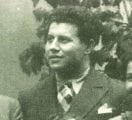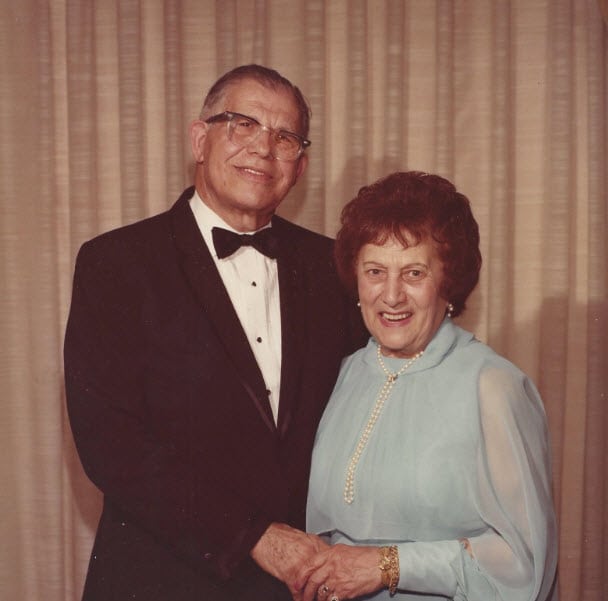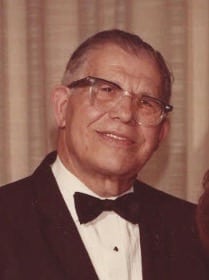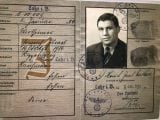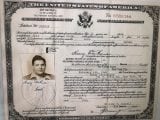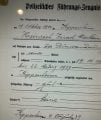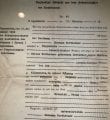- Local Survivor registry
- HENRY WERTHEIMER
- Local Survivor registry
- HENRY WERTHEIMER
Survivor Profile
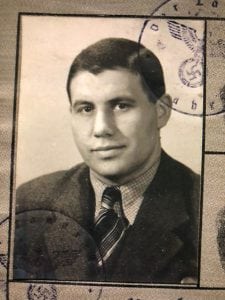
HENRY
WERTHEIMER
(1915 - 1982)
PRE-WAR NAME:
HENRY WERTHEIMER
HENRY WERTHEIMER
PLACE OF BIRTH:
KIPPENHEIM, GERMANY
KIPPENHEIM, GERMANY
DATE OF BIRTH:
OCTOBER 19, 1915
OCTOBER 19, 1915
LOCATION(s) BEFORE THE WAR:
KIPPENHEIM
KIPPENHEIM
LOCATION(s) DURING THE WAR:
DACHAU CONCENTRATION CAMP; LONDON, ENGLAND; WASHINGTON HEIGHTS, NEW YORK
DACHAU CONCENTRATION CAMP; LONDON, ENGLAND; WASHINGTON HEIGHTS, NEW YORK
STATUS:
SURVIVOR, REFUGEE
SURVIVOR, REFUGEE
RELATED PERSON(S):
ALICE ECKHAUS WERTHEIMER - Spouse (Deceased),
HERMAN WERTHEIMER - Father (Deceased),
SELINE DURLACHER WERTHEIMER - Mother (Deceased),
CARRIE SAUL - Daughter,
BOB SAUL - Son-in-law,
MICHAEL SAUL - Grandson,
STEVEN SAUL - Grandson
-
BIOGRAPHY BY NANCY GORRELL
Henry was the second child of Herman and Seline Wertheimer, religious Jews living in Kippenheim, a village in southwestern Germany near the Black Forest. Henry’s oldest sibling was his sister Rita, and the youngest was his brother, Kurt. Henry’s father owned a prosperous scrap metal factory in town. They were part of a large Jewish community, went to synagogue regularly and had family and friends, servants and chauffeurs. Henry was bar mitzvahed. According to Carrie, Henry’s daughter, in her interview, “They led a good life. They never thought this [the Holocaust] could happen.”
Yet, on November 9, 1938, the synagogue where Henry was Bar Mitzvahed, and the business his father owned were destroyed. Henry and his brother Kurt along with many of the other men of Kippenheim were taken to Dachau. Although her father never talked much about his experience, Carrie recalls one story he told her about Dachau. Since the two brothers were big, strong men, they had the task of ladling out soup to the prisoners: “My father walked with a garbage pail of soup and Kurt walked behind him ladling out the soup while the SS guards yelled at them in German, “faster, do it faster, faster.” After six weeks, Henry and his brother were released from Dachau to teach the Nazis how to run the scrap metal business back in Kippenheim.
After a short time, Henry, Kurt and their sister Isle managed to make their way to London, virtually penniless. Henry and Kurt worked there for two years as gardeners when finally a relative in the United States sponsored them to come. In 1940 they all left together for the United States, landing in Boston harbor by boat. According to Carrie, upon arrival in Boston, they had a nickel and went directly to a Horn and Hardart where they mixed ketchup with water and had tomato soup—their first taste of America. Somehow they made their way by bus to Washington Heights, New York where they settled in with their parents who had already emigrated from Germany through Italy to America (Henry’s mother had two brothers living in the United States at the time).
Henry began working as a Fuller brush man in Manhattan. He would go to the lower eastside and then he would sell the merchandise to people in Harlem on credit. He lived in an apartment building with his parents. According to Carrie: “Two flights up his widowed mother lived with her mother and my stepsister and brother, and she heard there was someone in the building not well, so she brought chicken soup down to the apartment.” That’s how Henry and his future spouse, Alice met. They and got married in 1942. Carrie, their first child was born in 1944. “My sister, brother and me grew up as one family.”
In 1946 when Carrie was two years old, the family moved to the Kingsbridge section of the Bronx. In the same year, on February 4, 1946 at the age of 31, Henry became a naturalized American citizen (Refer to Wertheimer documents in Related Textual Materials).
In the post war years, Henry became a successful, self-employed businessman selling merchandise throughout Manhattan. Henry passed in 1982 when he was 67 years old.
Editor’s Notes:
Refer to Historical Notes Below for Kippenheim and DachauRefer to Related Media and Textual Materials for Wertheimer historic documents
-
SURVIVOR INTERVIEW:
HENRY WERTHEIMER INTERVIEW WITH CARRIE SAUL, DAUGHTER
DATE: OCTOBER 14, 2017
LOCATION: Saul Residence, Basking Ridge, New Jersey
INTERVIEWER: Nancy Gorrell
Q: Describe your father’s family background.
My father was born and grew up in Kippenheim, a large city near the Black Forest in Germany. My father never talked much about his childhood. He never wanted to go back and he never returned. He had two sisters, Ilse and Rita. Rita was the oldest. He had a brother Kurt. His father owned a scrap metal factory. I know they were well off because they had chauffeurs.Q: What was Jewish life like in Kippenheim before Hitler?
They were happy and prosperous before Hitler. They were part of a large Jewish community. They never thought this (the Holocaust) could happened. There was a Jewish synagogue there, one of the largest in Germany that was completely destroyed during Kristallnacht. I think the synagogue was restored afterwards. My father’s family were observant Jews. My father was Bar Mitzvahed.Q: Did your father ever mention any anti-Semitism prior to the war?
The family was in denial. They felt they were Germans first. My father died young, at 67. He didn’t talk much about the past.Q: What happened to your father’s family during Kristallnacht?
The Nazis destroyed the business and the synagogue. That much I know. Nazis came in and took over the business and my father and his brother, Kurt, were sent to Dachau. They were there for six weeks, and then the Nazis released them to teach them how to run the scrap metal business.Q: Did your father ever talk about his experience in Dachau?
He told us one memory. My father and his brother were big, young and strong men. My father would walk with a garbage pail of soup, and Kurt would be ladling the soup out behind him, and the Nazis would be behind both of them yelling in German, “Do it faster, do it faster, faster!”Q: After they were released to teach the Nazis the business, what happened to them?
A relative in the United States sponsored them. My father, Kurt and Ilse made their way to London. They were penniless when they arrived and worked as gardeners for two years.Q: Do you know the name of the relative that sponsored them?
No. I don’t know the name. I do know they came on a boat to Boston in 1940. They arrived with only a nickel and went directly to Horn and Hardart and mixed ketchup with water and had tomato soup. My father did tell me that story.Q: Did they settle in Boston?
No. They went by bus to New York to reunite with their parents who had come over earlier. My mother had two brothers in America. She came through Ellis Island. My father’s parents came through Italy. My father, Kurt and Ilse went to Washington Heights. Rita, his other sister, was already married and in America at the time.Q: What was life like in Washington Heights for your father during the war years?
He worked very hard, but he had relatives and friends with common interests. He started as a Fuller brush man. And then he would go to the lower Eastside and then he would sell the merchandise to people in Harlem on credit. He moved in with his parents and siblings.Q: How is your father meet your mother?
Two flights up in the apartment in Washington Heights lived my widowed mother with her mother and my stepsister and brother. She heard there was someone in the building not well, so she brought chicken soup down to the apartment. They met and got married in 1942. I was born in 1944. My sister and brother and I grew up as one family.Q: What was life like for your family in the post-war period?
In 1946 when I was two years old, we moved to the Bronx to the Kingsbridge section. My father was self-employed businessman in New York. When I was five years old, we moved to a private home in Kingsbridge. My mom was a housewife.Q: Who survived in the family and who perished?
The immediate family, including my father’s parents, survived, but my father’s mother’s family mostly perished. My father did not come to America with any grandparents. Seline’s family perished. -
HISTORICAL NOTES:
Kippenheim and Dachau
Dachau concentration camp Dachau was the first of the Nazi concentration camps opened in Germany, intended to hold political prisoners. It is located on the grounds of an abandoned munitions factory northeast of the medieval town of Dachau, about 16 km (10 mi) northwest of Munich in the state of Bavaria, in southern Germany. Opened in 1933 by Heinrich Himmler, its purpose was enlarged to include forced labor, and eventually, the imprisonment of Jews, German and Austrian criminals, and eventually foreign nationals from countries that Germany occupied or invaded. The Dachau camp system grew to include nearly 100 sub-camps, which were mostly work camps or Arbeitskommandos,and were located throughout southern Germany and Austria. The camps were liberated by U.S. forces on 1 May 1945. Prisoners lived in constant fear of brutal treatment and terror detention including standing cells, floggings, the so-called tree or pole hanging, and standing at attention for extremely long periods. There were 32,000 documented deaths at the camp, and thousands that are undocumented. Approximately 10,000 of the 30,000 prisoners were sick at the time of liberation.
Kippenheim
General information: First Jewish presence: 1654; peak Jewish population: 323 in 1871; Jewish population in 1933: 144
Summary: This community established a prayer room in or around 1750, a synagogue in 1794, a new synagogue at Poststrasse in 1852 and a school in the 1830s, the last of which was presided over by a teacher who also served as the chazzan. Burials were conducted in the Schmieheim community’s cemetery, with which Kippenheim also shared a mikveh. Stef Wertheimer, the Israeli industrialist, was born in Kippenheim in 1926. Several Jewish associations were active in Kippenheim in 1933, and the teacher instructed 10 schoolchildren that year.The community continued to offer activities and lectures well into the Nazi period. On Pogrom Night, furniture and ritual objects from the synagogue were destroyed, as were its doors and windows. The building was set on fire, but residents extinguished the blaze out of fear for the safety of their own houses. Eleven Jewish men were sent to Dachau. Ninety-three Kippenheim Jews emigrated, seven died in Kippenheim, one committed suicide and 31, the last, were deported to Gurs on October 22, 1940. At least 31 Kippenheim Jews perished in the Shoah. The Jewish Restitution Successor Organization sold the synagogue after the war. In 1981, the town of Kippenheim acquired the building and declared it a national cultural monument. It has been used as a memorial and social hall since 2003.
-
related textual material:

HENRY'S IMMIGRATION DOCUMENT
-
Sources and Credits:
Credits:
SSBJCC Survivor Registry Interview, October 14, 2017 by Nancy Gorrell; Biography by Nancy Gorrell; Digital historic and family photographs and documents (birth certificate, immigration and naturalization) donated by Carrie and Bob Saul.
The Holocaust Memorial and Education Center gratefully acknowledges donation of historic documents by Carrie and Bob Saul.



